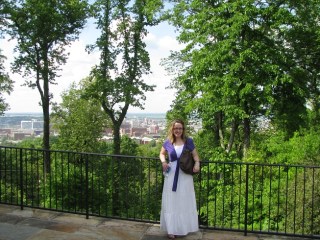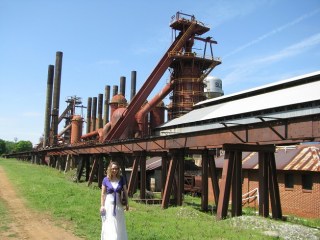 Yesterday was out first tourist day, and that meant Birmingham. We left at about 10:00 with the aim to be back home by 5:00, which seemed reasonable given that Birmingham is about an hour away. Normally. However, for some reason the state decided that in order to re-pave the northbound highway, they should shut the entire highway down and force everyone to exit at a local exit. By the time we navigated that little turn of events, it actually took us an hour and forty minutes to get to Birmingham. We’ll try an alternate route in the future.
Yesterday was out first tourist day, and that meant Birmingham. We left at about 10:00 with the aim to be back home by 5:00, which seemed reasonable given that Birmingham is about an hour away. Normally. However, for some reason the state decided that in order to re-pave the northbound highway, they should shut the entire highway down and force everyone to exit at a local exit. By the time we navigated that little turn of events, it actually took us an hour and forty minutes to get to Birmingham. We’ll try an alternate route in the future.
We were going “celebration of big industry” in Birmingham: we were starting our day at the old Sloss Furnaces, and were aiming to finish the day at the world’s largest cast-iron statue, the 1904 World Fair sculpture of Vulcan, which is on a hill in Vulcan Park.
Iron played a huge role in the founding and development of Birmingham. Three materials are needed to make iron – iron ore, limestone, and coal; Birmingham happened to have all three in abundance. When two major rail lines happened to cross in the area in the 1870s, the iron works and mines sprang up pretty quickly, and Birmingham grew very quickly.
The Sloss ironworks were founded in 1882 and produced iron for ninety years, until 1971. The entire operation was then donated to the city as a way to preserve the historical importance of iron to the area. It took awhile for people to get on board, but Sloss opened as an open-air museum in 1983. It is pretty cool – you wander around with a brochure that explains the machinery and the processes, and you go at your own pace. Not all of the mill is open to the public for safety reasons (they don’t let you climb up or down very often), but much of the foundry is open to wandering, and you may go where you like. That was fun.
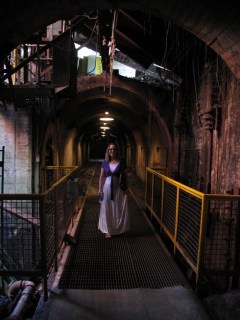 We had a slightly hot but beautiful day to wander. We learned about how water was used for steam and to cool the furnaces, and how trains unloaded loads of coal, limestone, and iron ore. There were placards that explained how the feeding of the two giant furnaces was largely automated in the 1920s, and how prior to that it took twenty men with wheelbarrows to keep the iron furnaces stocked. There were stories printed up from workers, and acknowledgments that the best jobs were for white people only for most of the history of the factory. Some of the jobs sounded awful – some men worked in the loading tunnel, which was always full of dust from coal or limestone or iron ore. Some men were bricklayers (bricks lined everything that got hot, which was a lot of things), and they said they were at risk of getting stuck in cramped spaces. The men who tended the top of the furnace had to be careful about carbon monoxide. Before automation, some men had to break up the finished iron bars (called pig iron because they looked like suckling pigs) while they were still hot, and had to carry them away. That job was described as the worst, and the information said only one in ten men could even do the job, and then only for a few years. Visiting large industrial sites always makes me glad to work in an office.
We had a slightly hot but beautiful day to wander. We learned about how water was used for steam and to cool the furnaces, and how trains unloaded loads of coal, limestone, and iron ore. There were placards that explained how the feeding of the two giant furnaces was largely automated in the 1920s, and how prior to that it took twenty men with wheelbarrows to keep the iron furnaces stocked. There were stories printed up from workers, and acknowledgments that the best jobs were for white people only for most of the history of the factory. Some of the jobs sounded awful – some men worked in the loading tunnel, which was always full of dust from coal or limestone or iron ore. Some men were bricklayers (bricks lined everything that got hot, which was a lot of things), and they said they were at risk of getting stuck in cramped spaces. The men who tended the top of the furnace had to be careful about carbon monoxide. Before automation, some men had to break up the finished iron bars (called pig iron because they looked like suckling pigs) while they were still hot, and had to carry them away. That job was described as the worst, and the information said only one in ten men could even do the job, and then only for a few years. Visiting large industrial sites always makes me glad to work in an office.
How iron was made went like this: trains brought in the raw materials and dumped them in a hopper, which weighed them. The hopper was then moved and its contents dumped into a steam-driven cart that carried the materials up to the top of the furnaces. The limestone, coal, or iron ore was dumped in, and fell toward the bottom. Meanwhile, super-heated air was forced into the bottom. The coal reacted with the air and burned very hot, and the iron ore melted while the limestone combined with impurities. That is way oversimplified; it seems as if the actual chemical process is very complex. But what you end up with is molten iron on the bottom of the furnace, and slag (waste product) floating on top of that. The slag was drawn off periodically to be used in construction materials, and the iron was drawn out every four hours or so. It was an interesting process to read about, and would be interesting to see.
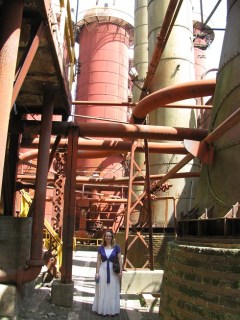 The self-guided tour took us about ninety minutes to complete, and took us around more than half of the full plant. It was all interesting, but a few things stood out. We were able to go down into the tunnel where the train cars dumped their loads; it felt like a bunker, and made me feel for the men who had to work in that crowded (and probably hot and dusty) space. The steam-powered lift that took loads to the top of the smelting furnace is high and steep, and can be seen from all over the plant. The oldest part of the plant held huge machines with twenty-foot flywheels the job of which was to generate the forced air that was then heated and sent into the bottom of the furnace.
The self-guided tour took us about ninety minutes to complete, and took us around more than half of the full plant. It was all interesting, but a few things stood out. We were able to go down into the tunnel where the train cars dumped their loads; it felt like a bunker, and made me feel for the men who had to work in that crowded (and probably hot and dusty) space. The steam-powered lift that took loads to the top of the smelting furnace is high and steep, and can be seen from all over the plant. The oldest part of the plant held huge machines with twenty-foot flywheels the job of which was to generate the forced air that was then heated and sent into the bottom of the furnace.
And hereby is an interesting story, and one of the lovely odd things that seem to happen to me and Mer when we travel. You cannot actually get into the room with the air pumps, but you can look through a bay door at them. The door is open, but roped off, so you can see pretty well. As I was looking at the two machines I could see, I noticed a few lights and screens set up, as for a photo shoot. I did not think too much about it – I figured there might be some publicity photos or the like being taken. I was rather surprised then to see a woman come around the corner next to the air compressors; she was wearing a Princess Leia-style metal bikini. She flung herself across one of the large industrial air compressors, and a photographer started snapping away. I looked at Mer and smiled, and we chuckled as we walked away. We found out later that it was a photo shoot to help a young photographer build his portfolio. Anyone can get a photo license from the museum with the proper paperwork, and he was using the machines as background. Mer later saw the model changing in to a sexy Robin Hood costume. It was all a bit surreal, and odd things make travel fun.
Mer and I took a bunch of photos of the plant, and of some of the machines scattered around. I’ve always been fascinated by pulley-driven steam shovels, and they had two on the grounds. They looked dangerous to run, with the operator standing (I could not see a seat) near all kinds of moving equipment.
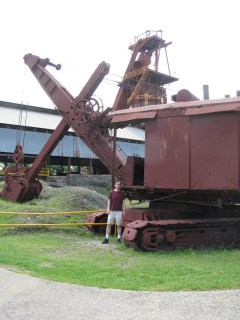 So, we had a good time at the Sloss Museum. I recommend it for anyone interested in history or industry or just in how things work.
So, we had a good time at the Sloss Museum. I recommend it for anyone interested in history or industry or just in how things work.
After we finished up Sloss, we headed out to go to Red Mountain, to Vulcan Park. The park is home to the fifty-six-foot-tall Vulcan statue, the world’s largest cast-iron sculpture. The sculpture is on a 124-foot-tall pedestal, on top of a mountain, so Vulcan is pretty visible. We got to the park and realized they had no food options, so we made a quick dash out of the park to an Italian deli for a quick bite; then we headed back.
The park is free, but it costs six dollars to see the small, but excellent, Vulcan museum and to go up to the outside observation deck on the tower. Mer and I tried the observation deck first, but I could not go out on the deck for long. It was open, with a steel grate floor, and my fear of heights kicked in. I fled back to the safety of the ground. Mer stayed up for a short while, and then she joined me. We looked around the park and used the location signs to locate specific Birmingham sights, including the Sloss Museum. We also got to read some of the history of Red Mountain, which was rich with iron ore.
We proceeded to the museum. The museum is only four large rooms, but they do a nice job. The first room explains how iron is made, and how it was central to Birmingham’s growth. The second room was the history and construction and renovation (in 1999) of the Vulcan statue. In brief, Vulcan was made for the 1904 World’s Fair in St. Louis, as a way to advertise Birmingham’s iron industry. It was made in a shockingly short time (just nine months), and was a huge (ha!) hit. The statue then lived at a “temporary” site on the fairgrounds in Birmingham for thirty years before being moved to the current park. The park was “modernized” in the 1960s, with the original tower being covered in marble and all the grounds being paved over for parking. The pictures were a sober reminder of how modern is not always good. The Vulcan statue, when placed on the tower, had been filled with concrete to stabilize the statue, which had been designed to be inside. Over the years, the concrete caused cracks in the iron of the statue, and in 1999 the park was closed for safety reasons, as the statue was starting to fall apart. Happily, the statue was restored and fitted with a steel skeleton, and the tower and grounds were restored more or less to how they were before the 1960s renovation. It is a very pretty place now.
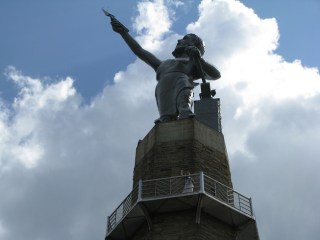 Anyway, the third room talked about how hard the depression hit Birmingham, with an estimated 100,000 of the 108,000 workers in the city out of work. The third room also talked about how Birmingham industry came roaring back to help supply the needs of World War 2.
Anyway, the third room talked about how hard the depression hit Birmingham, with an estimated 100,000 of the 108,000 workers in the city out of work. The third room also talked about how Birmingham industry came roaring back to help supply the needs of World War 2.
The last room talked about how Birmingham had transformed to a financial and telecom city. It also spent about half the room talking about the Civil Rights Movement in the 1960s, and Birmingham’s place in that. The four rooms gave a short but solid overview of the city’s history.
After the museum, we headed home. We got back to the house at about 5:00, and Kelly and Paul had grilled ribs and chicken. We all ate together, and then cleaned up. Kelly had a group of friends coming over to play a dice-based game called Bunco. It was a girls’-night thing, so Mer was invited and happy to play. I retreated to the third floor, where I blogged and watched some TV. Once I got tired of that, I went for a walk to Cold Stone Creamery to get ice cream. I very much enjoyed people-watching in a college town on a warm evening – there were people everywhere. Once I got home, Mer and I caught up with each other, and shortly thereafter I went to bed.
